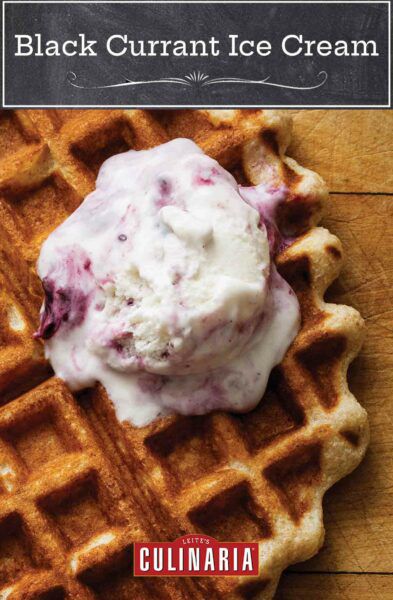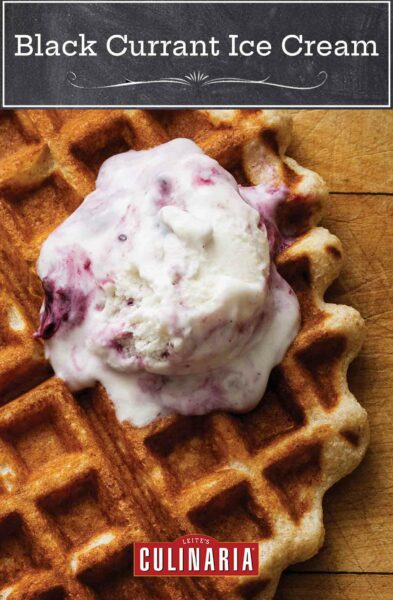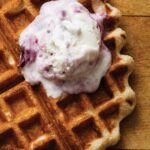

Black currant ice cream. It’s simply a swirl of slightly tart black currant jam swirled through a rich, creamy, unobtrusive sweet cream ice cream. Perfect on its own, in a waffle cone, or heck, even a la mode atop waffles.

This ice cream is sort of like the Italian classic fior di latte since this one doesn’t even include vanilla extract. We wanted a purer flavor for the jam. In the end, the taste here is all about the jam. Buy the best you can comfortably afford.–Mark Scarbrough and Bruce Weinstein
WHY IS POTATO STARCH USED IN ICE CREAM?
In the simplest terms, it’s a stabilizer. Cornstarch is commonly used but potato or rice starch are both great alternatives. And the reason for the stabilizer? This recipe has one big missing ingredient for ice cream—eggs. Without cooking egg yolks into the dairy and making a rich custard, your ice cream is going to be thin and melt faster than you’d like. Starches are used extensively in Italian gelato, giving them their recognizable texture. Ice cream without eggs will be a little lighter (because of the absence of fat from the yolks) but potato starch will still give you the creamy thickness that you desire.
Black Currant Ice Cream

Black currant ice cream. It’s simply a swirl of slightly tart black currant jam swirled through a rich, creamy, unobtrusive sweet cream ice cream. Perfect on its own, in a waffle cone, or heck, even a la mode atop waffles.
Make the ice cream base
-
In a large saucepan over medium-low heat, combine the sugar, potato starch, and salt. Vigorously whisk a small portion of the cream and milk into the saucepan, adding just enough to form a slurry, ensuring all the lumps are gone. Then whisk in the rest of your milk and cream. Continue to whisk all the ingredients until the sugar dissolves completely. Continue cooking, whisking frequently (and, in fact, more and more frequently as time goes on) until the mixture is thick and bubbling, 10 to 12 minutes.
-
Pour the mixture into a bowl and let cool to room temperature. Cover and refrigerate for at least 4 hours or up to 2 days, covering once the mixture is cold—be sure to press your cling wrap directly against the surface so as not to form a skin.
Churn and set the ice cream
-
Stir the cream mixture to recombine and then freeze it in your ice cream machine according to the manufacturer’s instructions, processing the ice cream until you can spoon up a mound and the edges don’t instantly start melting.
-
Spoon some of the ice cream into a loaf pan, top with a thin layer of the jam, add more ice cream, more jam, and on and on, until it’s all in the pan, finishing up with a layer of ice cream. Think of yourself as an ice cream bricklayer—constructing jammy heaven one layer at a time. You’ll make ribbons in the ice cream later as you scoop it up to serve. Cover and freeze until the desired consistency, at least 4 hours. You can store the ice cream in a sealed container in the freezer for up to 1 month.
Serving: 0.5cup, approximatelyCalories: 327kcal (16%)Carbohydrates: 28g (9%)Protein: 3g (6%)Fat: 23g (35%)Saturated Fat: 14g (88%)Polyunsaturated Fat: 1gMonounsaturated Fat: 7gCholesterol: 85mg (28%)Sodium: 80mg (3%)Potassium: 136mg (4%)Fiber: 1g (4%)Sugar: 21g (23%)Vitamin A: 936IU (19%)Vitamin C: 2mg (2%)Calcium: 87mg (9%)Iron: 1mg (6%)
Originally published September 03, 2017
![]() If you make this recipe, snap a photo and hashtag it #LeitesCulinaria. We’d love to see your creations on Instagram, Facebook, and Twitter.
If you make this recipe, snap a photo and hashtag it #LeitesCulinaria. We’d love to see your creations on Instagram, Facebook, and Twitter.


